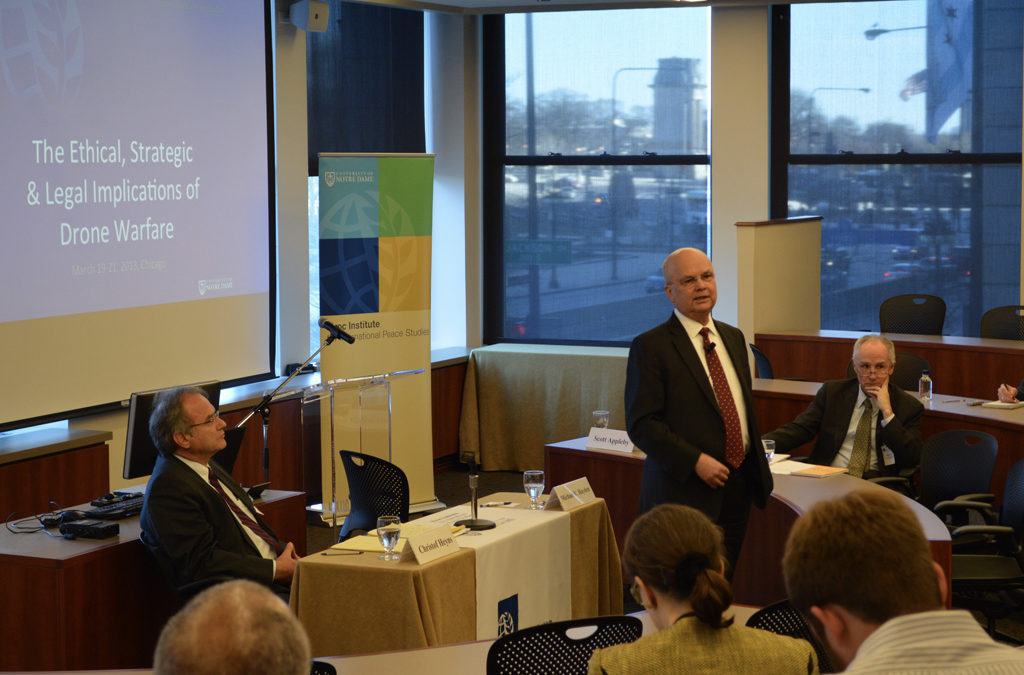The Obama administration claims that drone strikes are directed at known leaders of Al Qaeda. The majority of those killed in these attacks, however, are insurgents from the Taliban and other locally based militant movements.
At the drone warfare conference, Peter Bergen (New America Foundation) observed that the drone program has evolved into a counterinsurgency air platform. He reported that only 8 percent of those targeted since 2009 have been directly affiliated with Al Qaeda. So-called ‘signatures strikes’ are not directed against designated Al Qaeda leaders but rather target unidentified potential militants in certain locations.
Chris Woods (Bureau of Investigative Journalism) echoed the concerns of Christof Heyns (UN Special Rapporteur on extrajudicial, summary or arbitrary executions) about so-called double-tap strikes that target first responders and the funerals of the victims of prior attacks. These policies increase the risk of civilian casualties and inflame local hatreds and animosity toward the U.S.
AN INEFFECTIVE APPROACH
The use of military force is not an effective means of countering terrorism. As several speakers noted, you can’t kill your way to victory in the war against terrorism. Decapitation (killing of leadership) is not an effective strategy for ending terrorist organizations. Evidence shows that drone attacks temporarily reduce incidents of terrorist violence in the vicinity of a strike, but levels of violence outside the strike zone remain high or increase.
Drone strikes can have the effect of merely displacing violence to other locations, Rafia Zakaria (Amnesty International) noted in her remarks. In Pakistan, more than 40,000 people have been killed in the last decade in armed conflict among militant groups and in operations by the Pakistani government. U.S. drone strikes have caused 2,000 deaths directly, according to Pakistani government figures cited by Woods, and have contributed to militancy and instability by triggering population displacement that upsets fragile ethnic balances.
A TOOL FOR MILITARY RECRUITMENT
The most important metric in assessing the threat from extremist groups is the rate of militant recruitment. The primary strategic objective is to diminish public acquiescence or support for Al Qaeda and related militant groups and to drive down the recruitment rate. There is no evidence that drone strikes are achieving that goal. On the contrary, U.S. military intervention and drone warfare may be compounding the factors that increase support for terrorism and insurgency. As Audrey Kurth Cronin (George Mason University) observed, there is no firm evidence that drone strikes are capable of ending violent extremist groups. They have the effect of driving enemies together rather than dividing or weakening their ranks.
It is a mistake to suggest that drones are the only available option or that it is ‘drones or nothing’ in countering terrorism. Panelists at the conference emphasized the need for a greater focus on law enforcement methods as an alternative to drones strikes and the use of military force. The UN Strategy Against Terrorism, unanimously adopted by the General Assembly in September 2006, calls for a greater focus on addressing conditions conducive to violent extremism, as well as greater efforts to protect human rights and build state and international governance capacity.
POLICY CHALLENGES AND OPPORTUNITIES
As Bergen and other panelists noted, drone warfare policies may be unpopular in Pakistan and other countries, but they have strong public backing in the United States. Opinion polls in the U.S. show solid majorities in favor of drone strikes. Arguments that directly challenge the use of drone weapons are unlikely to gain public support.
Opponents of drone weapons have focused on the problem of collateral damage and civilian casualties, but the number of civilians killed in drone strikes in Pakistan has dropped sharply in recent months. As Woods noted, opposition to drone strikes cannot be based on the question of civilian casualties. Public advocacy on drone warfare will need to focus on ending the practice of illegal targeted killing, reclaiming civil and human rights, and enhancing security through more effective strategies for preventing violent extremism. Opportunities to highlight these themes will likely increase in the future as the Obama administration responds to legal challenges and demands for greater Congressional oversight.
Reported plans to place drone policies under military command may provide opportunities for public engagement and debate. Military control is no panacea, but it could provide a greater degree of accountability in the use of drone weapons, since members of the armed services can be held liable for violations of law under the Uniform Code of Military Justice.
A significant opportunity to advocate for an end to the war on terror may arise in 2014, as U.S. forces return home and end their combat role in Afghanistan. A call for Congress to withdraw the Authorization to Use Military Force could be combined with support for a more comprehensive strategy against violent extremism that relies less on military force and more on violence prevention strategies. Greater priority should be given to international law enforcement, the promotion of human rights, and the advancement of diplomatic, development, and peacemaking policies that can ameliorate the conditions that give rise to terrorism.
Addressing the challenges posed by drone warfare will require sustained engagement by a broad network of advocacy and research groups concerned with maintaining ethical and legal standards, protecting civil and human rights, and creating more effective U.S. policies against violent extremism and for peace and security.
— David Cortright



